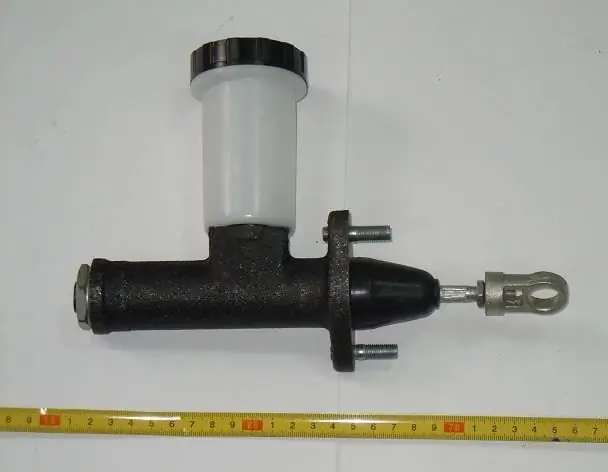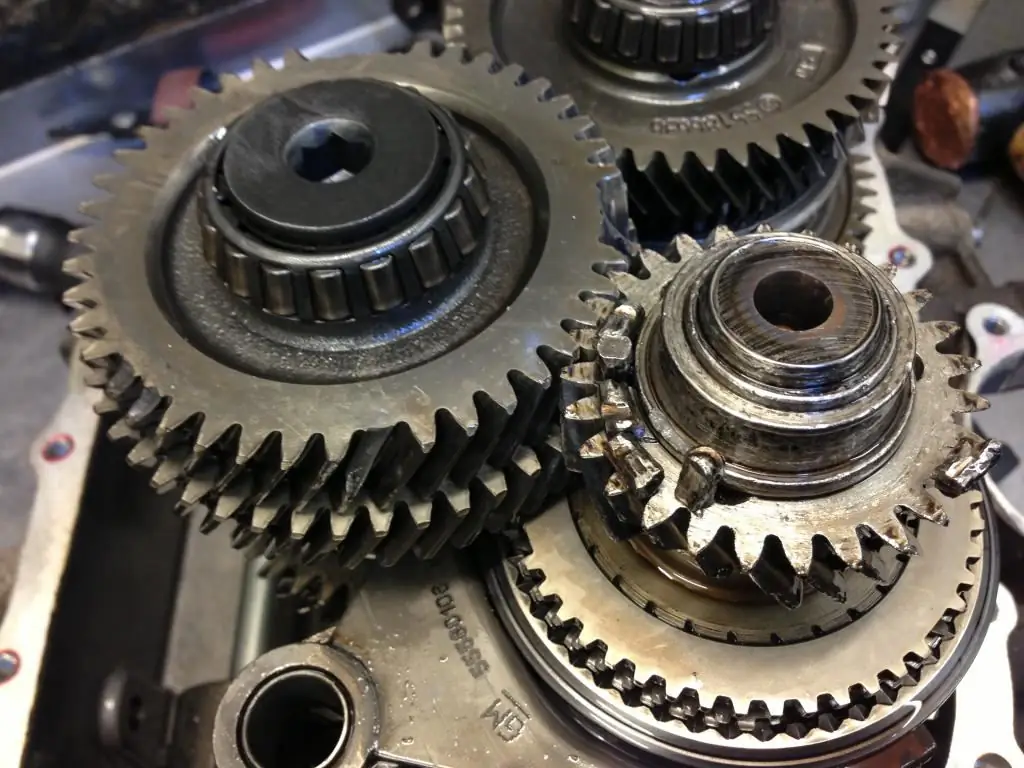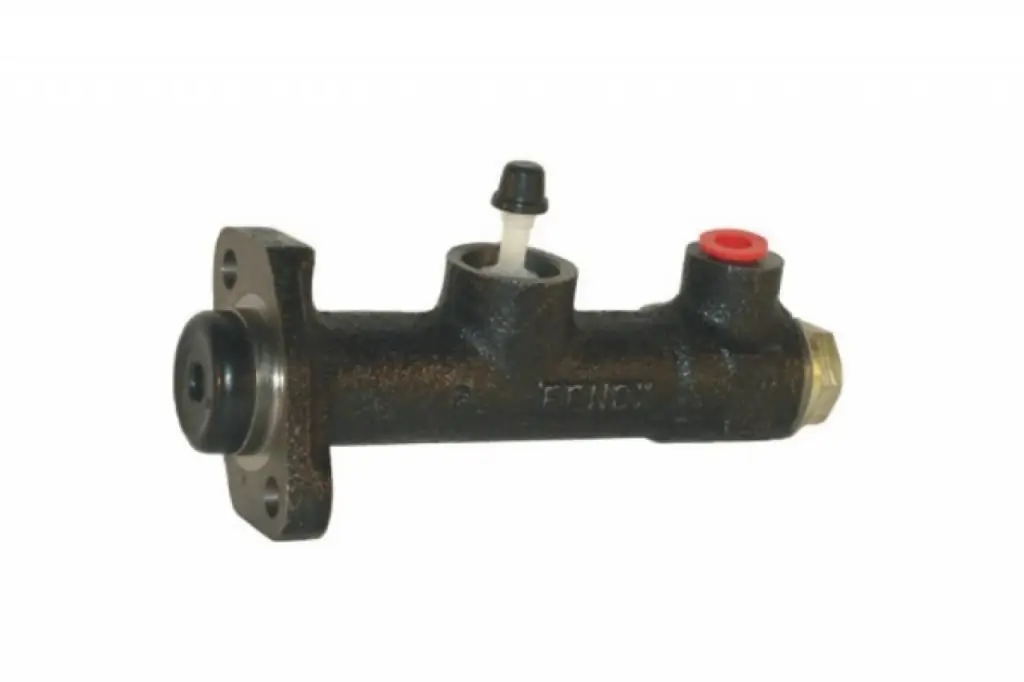2025 Author: Erin Ralphs | [email protected]. Last modified: 2025-01-22 21:14:12
The use of hydraulic drive in the "seven" is caused by the design features of its clutch. It not only transfers force to the driven disk, but also allows the car to start off smoothly. True, this somewhat complicated the design of the car and its operation. Therefore, it is necessary to know how the VAZ-2107 clutch cylinder works, the principle of its operation and operating features.
What is hydraulic drive
The clutch in the car is controlled by the pedal. The force from it to the disk can be transmitted in two ways:
- Using a rope.
- Hydraulic driven.
The first method is the simplest and most common, while the second is used in the "seven". Its essence, without going into details, is as follows.
The hydraulic drive consists of two cylinders connected by tubes and hoses. Structurally, it is done in such a way that pressing the clutch pedal leads to a significant increase in pressure insystem. It is mechanically transmitted to the driven disk and disconnects the transmission from the engine. The key elements of the system are two clutch cylinders VAZ-2107: main and working. One of them transforms the force acting on the pedal into excess pressure in the tubes of the system, the other does the reverse work, while acting on the driven disk.

VAZ-2107 clutch design
The main components of the "seven" hydraulic drive are:
- Main cylinder.
- Metal tube system.
- Clutch slave cylinder VAZ-2107.
- Pedal equipped with pushrod.
- Clutch fork.
The master cylinder is combined with a reservoir into which the brake fluid is poured. It is located under the hood of the car, on the wall of the engine compartment. This location allows for a mechanical connection between the cylinder and the clutch pedal. For this, a steel rod, the so-called pusher, is used.
The working cylinder is attached with two bolts to the gearbox housing and the rod is connected to the fork. The entire length of the metal rod is threaded, which allows you to adjust the grip. Both cylinders are interconnected by a copper tube and hoses.

Principle of VAZ-2107 clutch operation
The force of pressing the pedal with the help of a rod is transmitted to the master cylinder of the VAZ-2107 clutch. The liquid in it is squeezed out into the pipeline. Due to the tightness of the system and the absence of air in it, the forcetransferred to the working cylinder. The rod, moving forward, acts on the fork, which presses the driven disk. Releasing the pedal causes reverse movement of the rods and brake fluid. As a result, the system returns to its original position.
It is obvious that the basis of the hydraulic clutch "seven" is precisely the cylinders. They bear most of the load in the form of repeated movement of the rod, during which hydraulic pressure also acts on the internal elements. Therefore, the cylinders are the first to fail. Since they are collapsible, and corresponding repair kits are available for sale, some malfunctions can be fixed on your own. True, more often motorists prefer to change the entire cylinder.
The fact is that in this case, the labor costs for repairs are often inadequate to the cost of the assembly. For example, the price of the VAZ-2107 clutch master cylinder is about 1,500 rubles, and it will take a decent amount of time to restore it, especially in the absence of experience. However, it is up to the owner of the "seven" to repair or buy a new one.
Design and operation of GCC VAZ-2107
The clutch master cylinder is a fairly complex assembly, consisting of a large number of parts. However, in order to understand the principle of work, it is enough to name the main ones. These include:
- GCC body with brake fluid reservoir;
- cylinder piston;
- fitting;
- return spring.
The principle of operation of the cylinder resembles the operation of a conventional piston pump and is as follows:pressing the clutch pedal causes the pusher to move, which acts on the piston. Moving forward, he creates a pressure in front of him, which is transmitted through the tubes and hoses to the working cylinder. Its rod extends and displaces the clutch fork, the driven disk disables the transmission. Releasing the pedal reverses the process.

Character failures
For various seals in the cylinder, a large number of rubber gaskets and cuffs are used. Most often, they are the cause of the unsatisfactory operation of the GCC. The symptoms will be as follows:
- clutch does not disengage;
- pedal not pressed;
- brake fluid leaks on cylinder body;
- clutch pedal does not return to its original position.
Such symptoms are typical not only for GCC malfunctions. Reliably, only streaks of brake fluid on the body indicate it. You will have to repair or change the VAZ-2107 clutch master cylinder, the price in the second case will be noticeably higher, but the service life will also be longer.

Removal and repair
Regardless of whether the owner decided to restore the GVC or preferred to buy a new one, the first step is to dismantle the old one. For work you will need:
- set of box wrenches;
- medium shaped screwdriver;
- pliers;
- brake fluid for refilling;
- repair kit for clutch cylinder VAZ-2107 (in case of repair);
- small capacityto drain the brake fluid.
The clutch master cylinder removal sequence is as follows:
- The brake fluid reservoir needs to be drained. This can be done with a syringe. However, it will be more professional and faster to loosen the clamp, remove the hose from the fitting and quickly substitute a suitable container under it.
- Unscrew the metal tube from the GCC with a 10 spanner and take it aside.
- Using a 13 socket, unscrew the two nuts securing the cylinder to the bulkhead of the engine compartment.
- GCC can be removed.
First of all, the cylinder needs to be inspected. This will help determine whether to repair or replace. It makes sense to restore the cylinder only if the rubber seals are worn. Work is carried out in the following sequence:
- Unscrew the plug at the end of the GCC, if necessary, it will have to be clamped in a vise.
- Pull out the return spring.
- Pry off the rubber cap with a screwdriver.
- Now you need to remove the retaining ring.
- Push out the cylinder piston with a screwdriver from the side of the unscrewed plug.
- Replace all rubber gaskets, rings and cuffs. To facilitate installation, they must first be lubricated with brake fluid.
Assembly and installation of the VAZ-2107 clutch cylinder is carried out in the reverse order. After installing the tank, it must be filled with brake fluid. True, the clutch will not work yet. Air must be removed from the system.

How to upgradeclutch
Removal of air from the system is necessary after any repair of the GCC. It is better to do the work with an assistant. Bleeding the clutch cylinder VAZ-2107 is carried out in the following sequence:
- prepare a small diameter hose and a container of brake fluid;
- fill the tank without topping up 1.5 - 2 cm to the top;
- slightly "release" the fitting of the working cylinder and put a hose on it;
- lower its second end into a container with brake fluid;
- depress and release the clutch pedal until all the air is out of the system, you can determine this by the absence of bubbles;
- as soon as this happens, it is necessary to fix the pedal in the depressed state and tighten the fitting;
- check clutch operation.

If necessary, the process should be repeated.
Recommended:
Clutch master cylinder. "Gazelle": device and repair of the clutch master cylinder

To set the car in motion, it is necessary to transmit torque from the engine to the gearbox. Clutch is responsible for this
The principle of operation of the variator. Variator: device and principle of operation

The beginning of the creation of variable programs was laid in the last century. Even then, a Dutch engineer mounted it on a vehicle. After such mechanisms were used on industrial machines
Windshield washer pump: device, principle of operation, inspection, repair and replacement

Mud on the roads is typical not only in autumn and spring, but also in winter and summer. Behind the cars, a long, impenetrable train stretches along the highway, instantly covering the windshield of the car behind with a film of dirt. The wipers and washer pump do their job, and you can go to overtake. But a sudden failure in the middle of the maneuver leads to the fact that two seconds later, nothing can be seen through the windshield. Slow down or keep going? What to do in this situation?
VAZ-2110: voltage regulator: principle of operation, device, circuit and replacement

Information about what functions the voltage regulator performs in the VAZ-2110. The principle of operation of the device is described, malfunctions are given, methods of verification
Planetary gearbox: device, principle of operation, operation and repair

Planetary gears are among the most complex gear boxes. With a small size, the design is characterized by high functionality, which explains its widespread use in technological machines, bicycles and caterpillar vehicles. To date, the planetary gearbox has several design versions, but the basic principles of operation of its modifications remain the same

